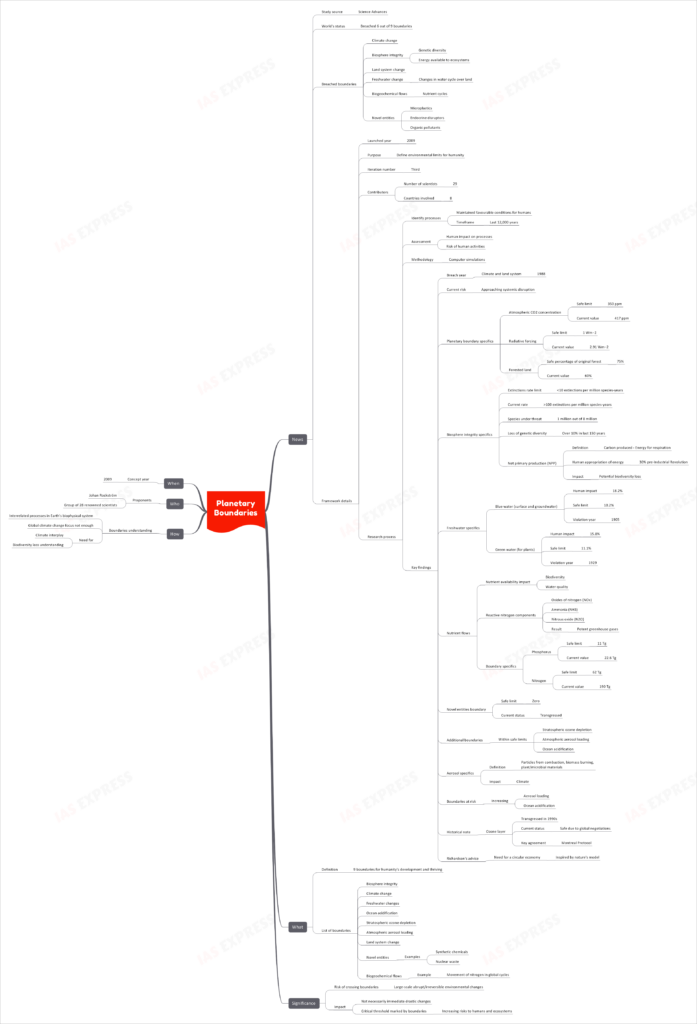Planetary Boundaries

In recent news, the state of our planet’s environmental health has been a topic of growing concern. A study published in Science Advances reveals that humanity is at a critical juncture, as we have breached six out of the nine identified planetary boundaries. This alarming revelation calls for immediate attention and action to address the impending environmental crisis.
This topic of “Planetary Boundaries” is important from the perspective of the UPSC IAS Examination, which falls under General Studies Portion.
Understanding Planetary Boundaries
Definition
Planetary boundaries refer to a framework that outlines nine crucial environmental limits for humanity’s development and thriving. These boundaries are essential for maintaining favorable conditions for human existence on Earth.
List of Boundaries
- Biosphere Integrity: Ensuring the protection of genetic diversity and the energy available to ecosystems.
- Climate Change: Regulating atmospheric CO2 concentration and radiative forcing.
- Freshwater Changes: Managing the impact on blue and green water resources.
- Ocean Acidification: Maintaining the delicate balance of ocean chemistry.
- Stratospheric Ozone Depletion: Protecting the ozone layer.
- Atmospheric Aerosol Loading: Controlling the presence of aerosol particles in the atmosphere.
- Land System Change: Preserving natural land ecosystems.
- Novel Entities: Preventing the introduction of harmful new entities like microplastics and endocrine disruptors.
- Biogeochemical Flows: Managing nutrient cycles, particularly nitrogen and phosphorus.
The Current State of Our Planet
Breached Boundaries
- Climate Change: The breach occurred in 1988, with current CO2 levels at 417 ppm (parts per million), exceeding the safe limit of 350 ppm.
- Biosphere Integrity: Genetic diversity and energy available to ecosystems are in decline.
- Land System Change: Natural land ecosystems have decreased, threatening biodiversity.
- Freshwater Changes: Both blue and green water resources have been significantly impacted.
- Biogeochemical Flows: Nutrient cycles, particularly phosphorus and nitrogen, have been disrupted.
- Novel Entities: The introduction of microplastics, endocrine disruptors, and organic pollutants poses a growing threat.
The Planetary Boundaries Framework
Inception and Purpose
The concept of planetary boundaries was introduced in 2009, with the aim of defining environmental limits for humanity’s well-being. This framework has undergone its third iteration and involves contributions from 29 scientists across eight countries.
Research Process
- Identifying processes that have maintained favorable conditions for humans over the last 12,000 years.
- Assessing human impact on these processes and the associated risks.
- Utilizing computer simulations to model various scenarios.
Key Findings
- The breach of climate and land system boundaries in 1988.
- The planet is currently approaching systemic disruption.
- Specifics of planetary boundaries:
- Atmospheric CO2 concentration: Safe limit at 350 ppm, current value at 417 ppm.
- Radiative forcing: Safe limit at 1 Wm−2, current value at 2.91 Wm−2.
- Forested land: Safe percentage of original forest at 75%, current value at 60%.
The Consequences of Crossing Boundaries
Risk of Crossing Boundaries
Crossing planetary boundaries poses a significant risk of large-scale abrupt and irreversible environmental changes, which could have dire consequences for both humans and ecosystems.
Impact
While the impact of boundary breaches may not result in immediate drastic changes, they mark critical thresholds that signal increasing risks to the well-being of both humans and the natural world.
Addressing Planetary Boundaries
Interconnected Processes
Understanding planetary boundaries requires recognizing the interrelated processes within Earth’s biophysical system. It’s essential to move beyond a narrow focus on global climate change and consider the broader implications for biodiversity loss.
Leading Figures in Planetary Boundaries
Proponents
- Johan Rockström: A prominent advocate for planetary boundaries and the co-chair of the Planetary Boundaries Research Network.
- Group of 28 Renowned Scientists: A dedicated team of experts working together to advance our understanding of planetary boundaries.

